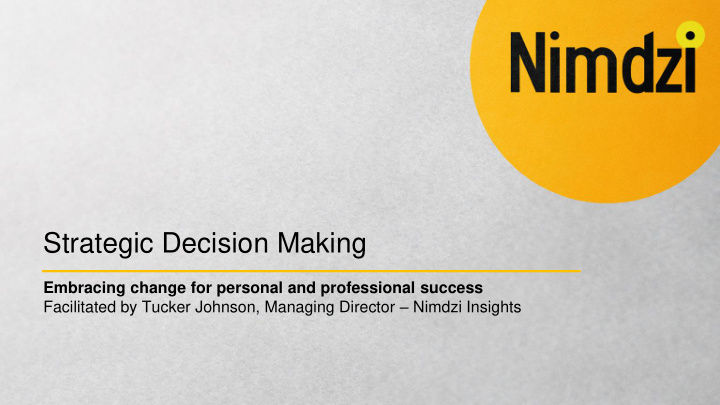



Strategic Decision Making Embracing change for personal and professional success Facilitated by Tucker Johnson, Managing Director – Nimdzi Insights
“Whenever you see a successful business, someone once made a courageous decision.” ― Peter F. Drucker
Good things about Tucker Bad things about Tucker • • 10 years experienced in LSP’s managing Not PMP certified operations • No SCRUM either • Emphasis on large account management • Six Sigma? What’s that? • Cofounder and Managing Director of • Can’t code without a “record macro” button Nimdzi Insights • • Way too American for his own good Author, “The General Theory of the Translation Company”
• What is your name? INTRODUCE • Where are you from? • What do you want to be when you grow up? YOURSELF • Why are you taking this class?
St Strategic ic Decisi ision Makin ing for r Lo Locali lizatio ion Le Leaders Introductory Session
In this workshop • Barriers to good decision-making • Seven steps do decision-making
Barriers to good decision-making What is holding you back?
ANALYSIS PARALYSIS
EXTINCTION BY INSTINCT
EMOTIONS
DECISION FATIGUE
PERFECTIONISM
Key points Own your decisions and take action – don’t fall victim to • analysis paralysis. Be a leader, not a dictator – don’t manage by instinct. • Acknowledge your emotions, but don’t let them drive you. • • Prioritize and delegate to avoid decision fatigue. • Perfection is the enemy of good enough.
Seven Steps The decision making process
1. IDENTIFY 2. GATHER 7. REVIEW INFORMATION Seven Steps for 3. IDENTIFY 6. TAKE ACTION Decision Making ALTERNATIVES 5. SELECT AN 4. ANALYZE ALTERNATIVE ALTERNATIVES
THINK OF A DECISION YOU ARE CURRENTLY FACING
Step 1: Identify Very important first step. • What is the problem/opportunity? • Clearly define the decision. • Outline success criteria. •
Step 2: Gather information • What information do you need? • Where will you get information? • Internal sources • External sources Where are you documenting the • information?
Step 3: Identify alternatives • What other actions/decisions are there? • Use your imagination. • Include others - brainstorming and ideation sessions can help with this phase.
Step 4: Analyze alternatives • Play out each alternative to the end. • Make a table or spreadsheet. • Step 1 is your benchmark. • Prioritize each alternative according to your analysis.
Step 5: Select an alternative • Choose the best alternative based on your weighting and analysis in Step 4. • It is OK to choose a combination of alternatives. • Inform interested parties of your decision and why you made it.
THREE FROGS WERE ON A LOG. ONE DECIDED TO JUMP OFF.
Step 6: Take action • What are the first steps? • Who needs to act? • What is the timeline? • Basic project management principles apply.
Step 7: Review • Has your decision resolved the challenge identified in Step 1? If not, then back to the drawing board. •
KEEP IT SIMPLE.
1. IDENTIFY Key Points • Take Step 1 seriously. 2. GATHER 7. REVIEW • Include internal as well as INFORMATION external sources of information in your research. • Include others in ideation. 3. IDENTIFY 6. TAKE ACTION • Don’t let perfection be the ALTERNATIVES enemy of good enough. • Always be reviewing processes and systems. • Discipline leads to confidence. 5. SELECT AN 4. ANALYZE ALTERNATIVE ALTERNATIVES
The only thing that is constant is change - Heraclitus of Ephesus
• Change management is not new, but is always CHANGE evolving – what is it, exactly? • Change management is a team process – MANAGEMENT what’s your role? • Common types of resistance to change – what’s WORKSHOP the problem? • Exercise: Eight steps for successful and sustainable change
Recommend
More recommend